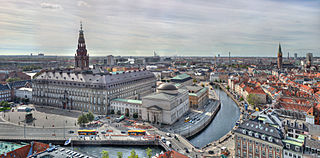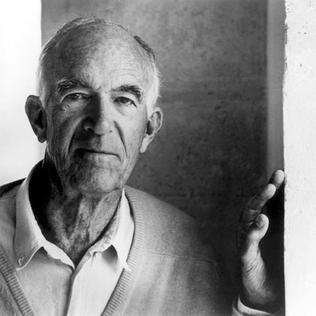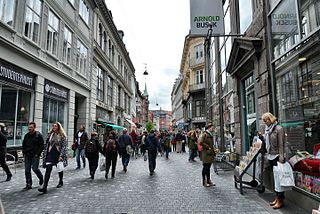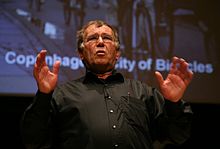
Copenhagen is the capital and most populous city of Denmark, with a population of around 650,000 in the municipality and 1.4 million in the urban area. The city is on the islands of Zealand and Amager, separated from Malmö, Sweden, by the Øresund strait. The Øresund Bridge connects the two cities by rail and road.

Jørn Oberg Utzon,, Hon. FAIA was a Danish architect. In 1957, he won an international design competition for his design of the Sydney Opera House in Australia. Utzon's revised design, which he completed in 1961, was the basis for the landmark, although it was not completed until 1973.

Strøget is a pedestrian, car free shopping area in Copenhagen, Denmark. This popular tourist attraction in the centre of town is one of the longest pedestrian shopping streets in Europe at 1.1 km. Located at the centre of the old city of Copenhagen, it has long been one of the most high-profile streets in the city. The pedestrianisation of Strøget in 1962 marked the beginning of a major change in the approach of Copenhagen to urban life; following the success of the initiative the city moved to place a much greater emphasis on pedestrian and bicycle access to the city at the expense of cars. This approach has in turn become internationally influential.

Nyhavn is a 17th-century waterfront, canal and entertainment district in Copenhagen, Denmark. Stretching from Kongens Nytorv to the harbour front just south of the Royal Playhouse, it is lined by brightly coloured 17th and early 18th century townhouses and bars, cafes and restaurants. The canal harbours many historical wooden ships.

Cycling advocacy consists of activities that call for, promote or enable increased adoption and support for cycling and improved safety and convenience for cyclists, usually within urbanized areas or semi-urban regions. Issues of concern typically include policy, administrative and legal changes ; advocating and establishing better cycling infrastructure ; public education regarding the health, transportational and environmental benefits of cycling for both individuals and communities, cycling and motoring skills; and increasing public and political support for bicycling.

City Hall Square is a public square in the centre of Copenhagen, Denmark, located in front of the Copenhagen City Hall. Its large size, central location, and affiliation with the city hall makes it a popular venue for a variety of events, celebrations and demonstrations. It is often used as a central point for measuring distances from Copenhagen.

Gammeltorv is the oldest square in Copenhagen, Denmark. With adjoining Nytorv it forms a common space along the Strøget pedestrian zone. While the square dates back to the foundation of the city in the 12th century, most of its buildings were constructed after the Great Fire of 1795 in Neoclassical style. Another dominating feature is the Caritas Well, a Renaissance fountain erected by King Christian IV in 1610.

Nytorv is a public square in the centre of Copenhagen, Denmark. Together with the adjoining Gammeltorv it forms a common space, today part of the Strøget pedestrian zone. The square is dominated by the imposing Neoclassical façade of the Copenhagen Court House, which from 1815-1905 also served as the City Hall.

Bjarke Bundgaard Ingels is a Danish architect, founder and creative partner of Bjarke Ingels Group (BIG).

The architecture of Denmark has its origins in the Viking period, richly revealed by archaeological finds. It became firmly established in the Middle Ages when first Romanesque, then Gothic churches and cathedrals sprang up throughout the country. It was during this period that, in a country with little access to stone, brick became the construction material of choice, not just for churches but also for fortifications and castles.

The architecture of Copenhagen in Denmark is characterised by a wide variety of styles, progressing through Christian IV's early 17th century landmarks and the elegant 17th century mansions and palaces of Frederiksstaden, to the late 19th century residential boroughs and cultural institutions to the modernistic contribution of the 20th century such as Arne Jacobsen's National Bank and SAS Royal Hotel.

Gråbrødretorv is a public square in the centre of Copenhagen, Denmark, just off the pedestrian street Strøget.

Amagertorv is a public square in the district of Indre By in central Copenhagen, Denmark. Today it forms part of the Strøget pedestrian zone, and is often described as the most central square in Copenhagen. Second only to Gammeltorv, it is also one of the oldest, taking its name from the Amager farmers who in the Middle Ages came into town to sell their produce at the site.

Fiolstræde is a pedestrianised shopping street in central Copenhagen, Denmark. It passes the square Frue Plads on its way from Nørreport station in the north to Skindergade in the south where Jorcks Passage connects it to the shopping street Strøget. Copenhagen Cathedral is located on the street which also passes the rear side of Copenhagen University Library.

Wakalat Street, sometimes spelled as Al-Wakalat Street, is a street in Amman, Jordan, in the district of Sweifieh. Its name means "brands" in Arabic, referencing the numerous brand-name clothing stores that line the commercial street.

Gehl is an urban research and design consulting firm based in Copenhagen, Denmark. It was founded in 2000 by Professor Jan Gehl and urban designer Helle Søholt as a continuation of Gehl's research within the area over the past four decades. The firm specialises in improving the quality of urban life by re-orienting city design towards the pedestrian and cyclist.

Søren Carl Theodor Marius Sørensen was a Danish landscape architect who is considered to be one of the greatest landscape architects of the 20th century. A contemporary of Thomas Church, Geoffrey Jellicoe and Luis Barragán he was a leading figure in the first generation of Modernists in landscape design. He is best known for designing the first Adventure playground in Emdrup, Copenhagen.

Købmagergade is a pedestrian shopping street in the Old Town of Copenhagen, Denmark. It connects Amagertorv on Strøget to Nørreport station, although the last section, north of Kultorvet, is part of Frederiksborggade, which continues on the other side of the railway station.

Kultorvet is a public square in the Old Town of Copenhagen, Denmark. Together with Købmagergade and the southern part of Frederiksborggade, it forms a pedestrian zone between Nørreport station and Amagertorv on Strøget. The square is lined with cafés and shops and is a popular venue for outdoor concerts in the summer time. Copenhagen Central Library was from the 1950s based on the square but has now relocated to a building in Krystalgade. Its old building has now been taken over by Niels Brock Copenhagen Business College.
Lene Dammand Lund is a Danish architect and educator. Since April 2012, she has been rector of the schools of architecture, design and conservation at the Royal Danish Academy of Fine Arts.




















